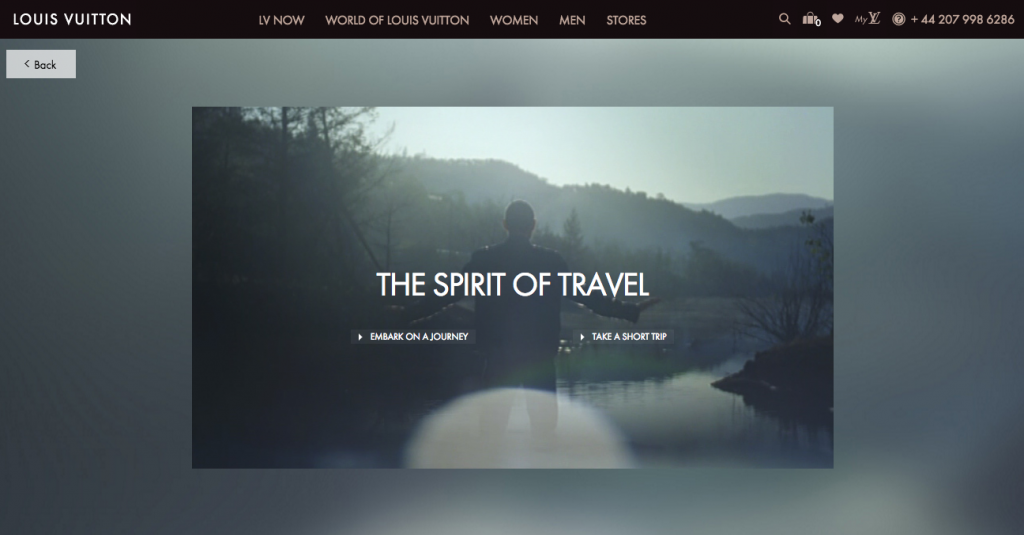Jan
2016
3 Ways Fashion Brands Use Digital Storytelling As Their ‘Secret Sauce’ of Social Media
‘Storytelling in the fashion industry can open up a world of creativity, when done right. It all begins with knowing your brand and understanding your audience. Once that is established, it’s all about making an emotional connection with your consumers,’ (Mines, 2015). This emotional connection, if done correctly, can ensure engagement in consumers and thus enhance their corporate reputation (Dijkmans, C., Kerkhof, P., & Beukeboom, C. J.,2015). Consumers are more likely to select companies with positive corporate reputations, and are willing to pay more for their products (Aula, 2010).
Before a company attempts to communicate their story digitally, it must remember that ‘people don’t buy into brands — they buy into the story behind brands’ (Mallon, 2016). Digital storytelling, combined with the power of social media, allows the brand to tap into the consumers’ emotional aspects of engagement, and create a direct link, which ideally leads to brand awareness (Juozaponyte, 2015).
Below there are three examples of fashion companies successfully executing digital storytelling:
Nastygal
In just less than 10 years, a young woman went from selling her own vintage clothing on ebay to founding what is now known as the fastest growing e-commerce site in the US. Sophia Amoruso, whether intentionally or not, has become the face of her own company. Amoruso’s story has sparked increasing interest as her company has grown over the years, with BBC calling it  ‘a Cinderella story’, which has been the centre of the company’s image ever since it was founded in 2006 (Gittleson, 2014). Amoruso used this fame to her advantage, by writing a New York Times Best Seller on success called ‘#Girlboss’, inviting fans to use this hashtag to spread awareness on social media. Nastygal’s website features links directly to the #Girlboss website, ensuring that every user that clicks on Nastygal reads its’ story to success.
‘a Cinderella story’, which has been the centre of the company’s image ever since it was founded in 2006 (Gittleson, 2014). Amoruso used this fame to her advantage, by writing a New York Times Best Seller on success called ‘#Girlboss’, inviting fans to use this hashtag to spread awareness on social media. Nastygal’s website features links directly to the #Girlboss website, ensuring that every user that clicks on Nastygal reads its’ story to success.
The Kooples
Instead of using their own story to share with their consumers, the Kooples uses the love story of real life couples or ‘Kooples’ to relate with audiences on all media channels. Each season, six new couples are chosen, with a caption of their names and how long they’ve been together for. This strategy creates an instantly relatable brand by using real, human connections that consumers can identify with, yet at the same time evoking the brands edgy personality and values. Although the couples are model look-a-likes, their relationships are just as important to the campaigns as their appearance. Using social media eff ectively, these stories are consistent but vary in detail from channel to channel. For example, a print ad will feature a picture of the couple and how long they’ve been together, and the audience is invited to check out The Koople’s Youtube channel, which features digital shorts that follow these couples around cities as they talk about their relationship directly to the camera (Walsh,2012).
ectively, these stories are consistent but vary in detail from channel to channel. For example, a print ad will feature a picture of the couple and how long they’ve been together, and the audience is invited to check out The Koople’s Youtube channel, which features digital shorts that follow these couples around cities as they talk about their relationship directly to the camera (Walsh,2012).
Louis Vuitton
This luxury fashion brand may be one of the very few of the upmarket designers to master digital storytelling and manage to communicate their values effectively. Invoking the brand’s heritage of ‘the art of travel’, with ‘Louis Vuitton Soundwalk’ –downloadable journeys through Beijing, Hong Kong, and Shanghai. Reaching out to international high profile bloggers, Louis Vuitton invited them to experience the ‘Soundwalk’ in Hong Kong, which facilitated progressive conversations around the brand. The bloggers then shared their experience with their followers through articles, comments, photos, and video footage. Luxury consumers see blogs as a more honest, reliable, and authentic source of information than the brand website (Okonkwo 2010). Therefore using bloggers to share their journey was an extremely interactive way to engage its consumers. The brand has continued to build digital journeys with its own website, http://www.louisvuittonjourneys.com. This invites consumers to go on their own journeys, and thus, share their digital story through the Louis Vuitton medium.
authentic source of information than the brand website (Okonkwo 2010). Therefore using bloggers to share their journey was an extremely interactive way to engage its consumers. The brand has continued to build digital journeys with its own website, http://www.louisvuittonjourneys.com. This invites consumers to go on their own journeys, and thus, share their digital story through the Louis Vuitton medium.
Critical Analysis:
You are NOT the Hero
It’s important for companies to remember that they are not the ‘hero’ of their story. According Ed Woodcock, all good brands understand that their customer should be the hero, with the brand’s purpose being to facilitate THEIR desires and dreams, not their own (2015). This is where Nastygal could improve. Their hero is Sophia Amoruso, and although she is incredibly inspirational, they must remember to always link it back with the consumer by relating her to their audience. Why is this story valuable to them (Klettke, 2014)? Perhaps Nastygal can improve by picking their most loyal customers each month and allowing them to share their own unique story, and make links to that of Amoruso’s. This is what the Kooples gets right in their storytelling for example, by picking ‘real’ people that their consumers may be able to relate to and connect with their consumers on a real emotional level, creating a ‘relatable’ brand.
Social Media Can Get Ugly
While social media is a great tool for reaching large audiences, it must not be forgotten that consumers have access to that exact audience as well. One bad experience can put the entire company’s reputation at risk, for example, the famous story of ‘United breaks guitars’, where one angry customer wrote a song about their experience and it reached worldwide recognition, harming United Airline’s reputation (2009). ‘Social media platforms are no orderly one-way channels for communication, but rather uncontrolled arenas for participation, which may pose a risk of reputation damage for firms (Aula, 2008)’. It is therefore important for Louis Vuitton to remember to understand their audience, and predict the contexts in which people may perceive the stories they are sharing. Thus when these bloggers share their own ‘journeys’, the content must be controlled by the brand, in order for the blogger not to experience any bad experiences along her journey. The web is known as ‘…a risky environment and corporations need to be creative as well as transparent and honest in order to captivate and communicate effectively with their various publics’ (Jones et al, 2010).
Lessons Learned:
- Consumers are much more engaged in a campaign if you evoke emotions
- But, you can only evoke emotions if the story you are telling is authentic
- Authentic story must also communicate brand’s core values
- Don’t just engage, interact with consumers – give them something to talk about
- Be Transparent to consumer – allow them to voice their opinions
- Positive/progressive conversation amongst consumers is valuable to a company’s corporate reputation
Appendix:
| The Seven Elements of Digital Storytelling |
| 1. Point of View – what is the perspective of the author? |
| 2. A Dramatic Question – a question that will be answered by the end of the story. |
| 3. Emotional Content – serious issues that speak to us in a personal and powerful way. |
| 4. The Gift of your Voice – a way to personalize the story to help the audience understand the context. |
| 5. The Power of the Soundtrack – music or other sounds that support the storyline. |
| 6. Economy – simply put, using just enough content to tell the story without overloading the viewer with too much information. |
| 7. Pacing – related to Economy, but specifically deals with how slowly or quickly the story progresses. |
(Robin, 2006)
References:
Aula, P. (2010). Social media, reputation risk and ambient publicity management. Strategy & Leadership, 38(6), pp.43-49.
Dijkmans, C., Kerkhof, P. and Beukeboom, C. (2015). A stage to engage: Social media use and corporate reputation. Tourism Management, 47, pp.58-67.
GIRLBOSS – #Girlboss is a platform inspiring women to lead deliberate lives. With intention, destiny becomes reality., (2015). home. [online] Available at: http://www.girlboss.com/ [Accessed 11 Jan. 2016].
Gittleson, K. (2016). Nasty Gal’s Sophia Amoruso: ‘Shoplifting saved my life’ – BBC News. [online] BBC News. Available at: http://www.bbc.co.uk/news/business-27414760 [Accessed 8 Jan. 2016].
Jones, B., Temperley, J. and Lima, A. (2009). Corporate reputation in the era of Web 2.0: the case of Primark. Journal of Marketing Management, 25(9-10), pp.927-939.
Juozaponyte, A. (2016). How Fashion Brands Use Digital Storytelling | 01storytelling. [online] 01storytelling.com. Available at: http://01storytelling.com/how-fashion-brands-use-digital-storytelling/ [Accessed 5 Jan. 2016].
Kiani, G. (2016). Marketing opportunities in the digital world: Internet Research: Vol 8, No 2. Internet Research, [online] 8(2), pp.185-194. Available at: http://www.emeraldinsight.com/doi/pdfplus/10.1108/10662249810211656 [Accessed 4 Jan. 2016].
Klettke, M. (2014). 3 Fatal Flaws of Failed Brand Storytelling. [online] iAcquire. Available at: http://www.iacquire.com/blog/brand-storytelling [Accessed 5 Jan. 2016].
Mallon, S. (2016). How to Use Digital Storytelling as your Social Media “Secret Sauce”. [online] Postplanner.com. Available at: https://www.postplanner.com/digital-storytelling-techniques-secret-sauce-social-media/ [Accessed 7 Jan. 2016].
McMahon, K. and Morley, J. (2016). Innovation, Interaction, and Inclusion: Heritage Luxury Brands in Collusion with the Consumer. [online] Iffti.com. Available at: http://www.iffti.com/downloads/past_conferences/IFFTI%20ABSTRACTS%20BROCHURE%202011.pdf#page=71 [Accessed 5 Jan. 2016].
Mines, R. (2015). How the Fashion Industry Wins with Marketing Storytelling | Tidal Labs. [online] Tidal Labs. Available at: https://tid.al/blog/ad-week-2015-fashion-indsutry-social-media-marketing-storytelling/ [Accessed 5 Jan. 2016].
Nastygal.com, (2016). Nasty Gals Do It Better. Shop Clothing, Shoes & Vintage | Nasty Gal. [online] Available at: http://nastygal.com [Accessed 5 Jan. 2016].
Okonkwo, U. (2010). Luxury online. London: Palgrave Macmillan.
Reinartz, W., Krafft, M. and Hoyer, W. (2004). The Customer Relationship Management Process: Its Measurement and Impact on Performance. Journal of Marketing Research, 41(3), pp.293-305.
Robin, B. (n.d.). The Educational Uses of Digital Marketing. University of Houston. [online] Available at: http://file:///Users/ErenGencler/Documents/School/Third%20Year/Digital%20Marketing/7%20Principles%20Digital%20Storytelling%20Robin.pdf [Accessed 8 Jan. 2016].
Robinson, C. (2016). Fight Club, Cinderella, and What Storytelling Means for Brands via @PostAdvertising. [online] Postadvertising.com. Available at: http://www.postadvertising.com/2012/10/what-storytelling-means-for-brands/ [Accessed 10 Jan. 2016].
Thekooples.com, (2016). The Kooples. [online] Available at: http://www.thekooples.com/en/identity/#/couples [Accessed 7 Jan. 2016].
Walsh, R. (2012). Meet the Kooples. [online] Irishexaminer.com. Available at: http://www.irishexaminer.com/lifestyle/features/meet-the-kooples-214774.html [Accessed 5 Jan. 2016].
Woodcock, E. (2014). Know your hero: ten rules of brand storytelling. [online] the Guardian. Available at: http://www.theguardian.com/media-network/marketing-agencies-association-partner-zone/ten-rules-marketing-brand-storytelling [Accessed 8 Jan. 2016].
YouTube, (2016). The Kooples. [online] Available at: https://www.youtube.com/user/TheKooplesOfficial [Accessed 27 Jan. 2016].
YouTube, (2016). United Breaks Guitars. [online] Available at: https://www.youtube.com/watch?v=5YGc4zOqozo [Accessed 30 Jan. 2016].